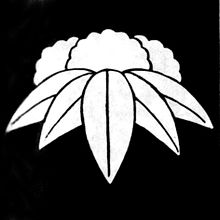Matsudaira (Nomi)
The Nomi-Matsudaira ( Japanese 能見 松 平 家 , Nomi-Matsudaira-ke ) were a family of the Japanese sword nobility ( Buke ), which was derived from Matsudaira Mitsuchika . She had settled in Nomi ( Mikawa ) and adopted that name. With an income of 32,000 Koku , the Nomi , who last lived in Kitsuki ( Ōita Prefecture ), was one of the smaller Fudai daimyo of the Edo period .
genealogy
- Shigeyoshi ( 重 吉 ; 1498–1580) successively served Tokugawa Kiyoyasu, Hirotada and Ieyasu .
- Shigekatsu ( 重 勝 ; 1548-1620) received 1612 Sanjō ( Echigo ) with 20,000 Koku. He was transferred to Sekiyado ( Shimousa ) in 1617 and then to Yokosuka ( Tōtōmi ) in 1619 , both with 26,000 koku. His descendants resided from 1622 in Kaminoyama ( Dewa ) with 40,000 Koku, from 1626 in Sanda ( Settsu ) with 30,000 Koku, from 1632 in a permanent house ( Jinya ) in Ryūō ( Buzen ) with 37,000 Koku and from 1639 a castle in Takada ( Bungo ) and then from 1645 to 1868 in Kitsuki (Bungo) with 32,000 koku. The last daimyo was
- Chikataka (親貴; 1838–1882), after 1868 vice count .
Remarks
- ↑ Today a district of Gamagōri .
- ↑ Today a district of Noda .
- ↑ Today a district of Kakegawa .
- ↑ Today part of USA .
- ↑ Today a district of Miyama .
- ↑ Since 1712 杵 築 written, previously 木 付 .
Individual evidence
- ↑ Yamanouchi: Kitsuki-jo . In: Miura, Masayuki (ed.): Shiro to jinya. Saikoku-hen . Gakken, 2006, ISBN 978-4-05-604379-2 .
literature
- Papinot, Edmond: Historical and Geographical Dictionary of Japan. Reprinted by Tuttle, 1972 edition of 1910 edition. ISBN 0-8048-0996-8 .
